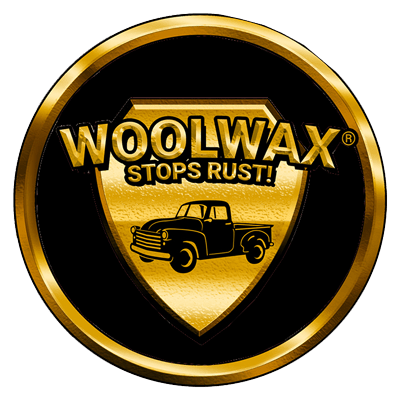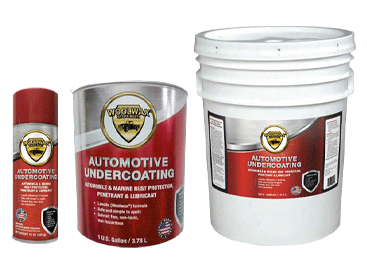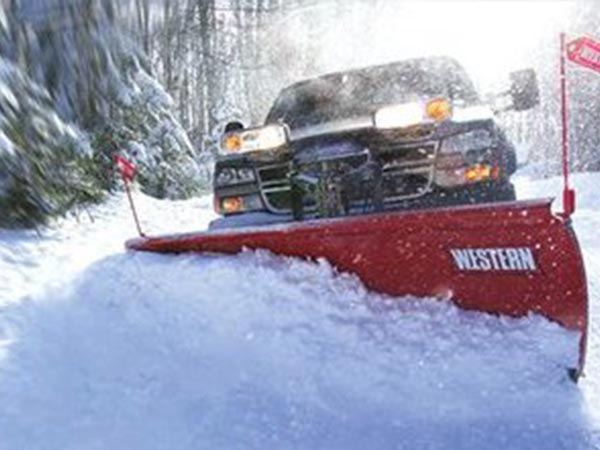WoolWax Undercoating Formula is a lanolin-based corrosion inhibitor developed solely to protect the undercarriages of automobiles and trucks. Their lanolin is blended with other proprietary agents to provide long term corrosion protection. WoolWax® will provide long term protection (annual application) against salt, liquid calcium chloride, brine, and all other ice control agents that are being used by municipal departments.
WOOLWAX can be applied to metal surfaces to protect them from the elements. It is all-natural and will not harm paint or electric components.
WoolWax is built to last longer! Available in clear and black.





Both products can be easily sprayed with the “PRO” Undercoating Gun from Kellsport Products. Woolwax® being thicker, has much less overspray (misting).
Woolwax® is geared more towards the industrial user, professional undercoaters, or users in areas with heavy amounts of road slush that may want a slightly thicker product for more resistance to wash-off with very little noticeable smell.
Woolwax® is manufactured 100% in the U.S.A. The only raw material imported is the wool grease, because it is not available here. Everything other raw material, and the packaging, labels, boxes, tint(black), is proudly manufactured in the U.S.A.
We have hundreds of undercoaters throughout the country that apply Woolwax® to customers’ vehicles. Enter your zip code on our website under “Find an Undercoater”. If there is no location near you, consider purchasing one of our Do-It-Yourself kits. All you need is a small compressor. Woolwax® is non-toxic, non-hazardous, and very easy to apply.
Because Woolwax® is non-drying, Woolwax® will attract an initial coating of sand/dirt. Anything that may adhere can easily be rinsed off with a low-pressure garden hose. Because Woolwax® contains no solvents, it will not become tacky or sticky and create a dirt buildup. Many of our professional Undercoaters advise their customers to drive down a dirt road after Woolwax® application. They say that the outer coating of sand gives the coating an extra layer of protection, and stops salt from sticking to it. Years ago when they used to undercoat with motor oil most people were always advised to drive on a dirt road as soon as possible. There must be something to this strategy, as it is still recommended by many professionals today.
Woolwax® is very thick and does not wash off easily. Anything dirt or salt that may adhere can easily be rinsed off with a low-pressure garden hose.
Our Undercoat guns do not need to be cleaned after use when using with Woolwax®. Woolwax® undercoating is solvent-free, so there is no evaporation or hardening process. The Woolwax® left in the bottle will thicken over time. But you can restore to its original viscosity by shaking vigorously.
Some people do prefer to clean the gun and wands. To do this we recommend just putting some solvent (acetone, mineral spirits, paint thinner, etc.) into one of the bottles and spraying a bit through the gun. Some people just put water and dishwashing liquid into the bottle, and they say that it works fine.
Most people just leave the gun loaded and ready to go without doing anything at all. That way you can do a quick touch-up or spray some outdoor power equipment with almost no setup time.
Bottom line……. Don’t worry about the undercoat guns when using Woolwax®. They won’t clog.
Woolwax® is an annual maintenance application. A Woolwax® treatment will easily provide protection through even the harshest of winter conditions. Woolwax® is extremely resistant to wash-off. Woolwax® contains no solvents, so there is no evaporation process. In the protected enclosed areas (doors, frame rails, etc.) a single treatment will provide protection for an indefinite period of time (years). The exposed area of the undercarriage should be re-treated annually. There is no need to remove or power wash the existing Woolwax®. Simply give it a rinse with a garden hose to clean it up a bit, and apply a fresh coat right over the existing Woolwax®. Many of our Undercoaters suggest treating vehicles in the warmer weather so that the Woolwax® creeps and migrates into all the inaccessible areas.
Woolwax® is extremely resistant to wash-off because it is so thick. In the enclosed protected areas Woolwax® will last for years. The exposed areas of the undercarriage need to be reapplied annually.
Woolwax® forms a lanolin film barrier on the base metal that moisture and oxygen cannot penetrate. Without these (2) components, corrosion cannot occur. Because Woolwax® does not dry, it is self-healing. If something scrapes it or road debris hits it, the Woolwax® will “gel over” and repair itself.
During the winter salt/snow season we don’t recommend any high-pressure washing of the vehicle undercarriage. A low pressure rinsing with a garden hose will not remove the Woolwax®, as it is very resistant to wash-off. Many car-wash facilities can turn off the undercarriage wash as you go through. Some charge extra for the undercarriage wash to be turned on. We have many users tell us they regularly take their vehicles to the car-wash during the winter, and it has no effect on the Woolwax® coating. That being said, we still don’t recommend washing the undercarriage during the winter season with any high-pressure systems.
There is not much to avoid. Naturally, try to keep the Woolwax® away from the brake rotors. Woolwax® has a very high flash point (>400°), so in any of the hot areas like mufflers, oil pans, etc., it will just burn off within a few minutes. Woolwax® works well to protect electrical wiring and electrical connections. Woolwax® is non-conductive. Make the connection (battery terminals, etc.) and then apply.
Many people have concerns about Woolwax® on rubber materials. Almost everything on an undercarriage is oil resistant. We have had no known issues of Woolwax® having any negative effects on oil-resistant rubber components. We have seen discussions about rubber breaking down and falling through the normal deterioration process. Rubber does dry out, cracks, and fails during its normal life cycle. Some people believe this may be a result of an undercoat application, but more than likely the rubber component has just reached the end of its life cycle through normal deterioration and exposure to vehicle heat and road chemicals.
We have heard of issues with the soft spongy rubber weather strips around the bottom of the door frames. This is an open-cell sponge rubber and is not oil resistant. There have been reported instances of this type of open-cell soft rubber swelling up when being exposed to lanolin-based products.
There have been no known incidents of Woolwax® having any negative effect on any paint or plastics. If you do get some over-spray to the paint, just rub it in like car wax. There is no need to remove it.